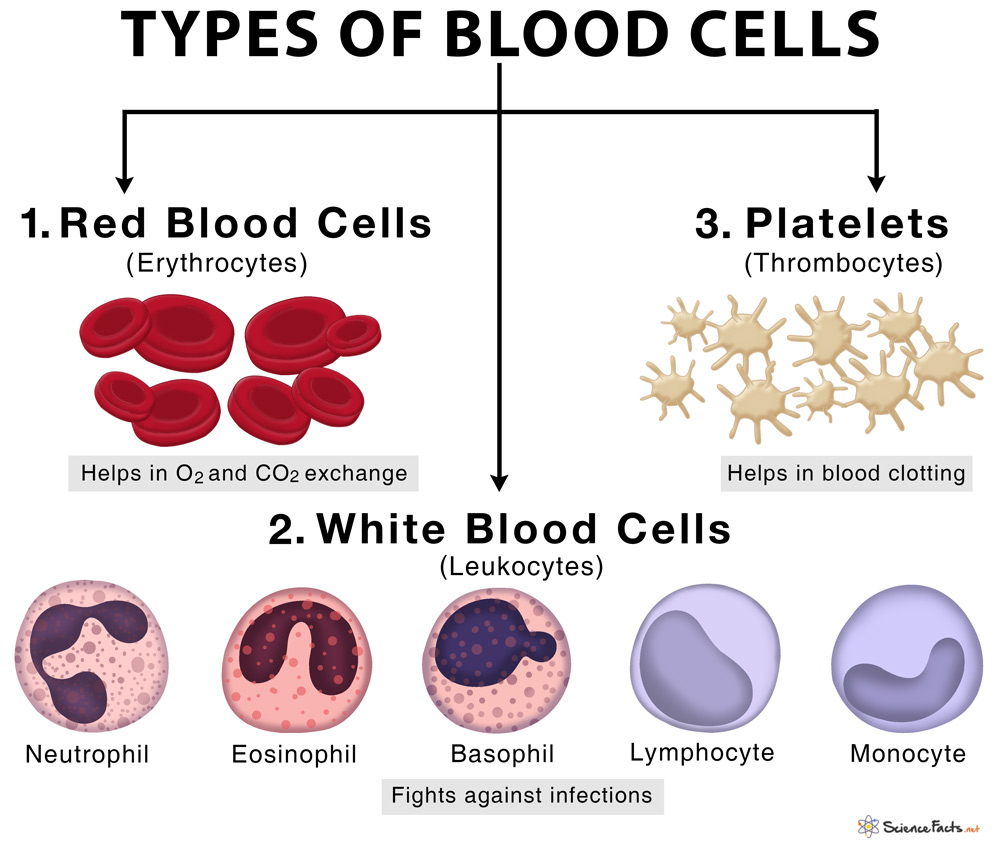Types of Blood Cells With Their Structure, and Functions
Blood cells, also known as hematopoietic cells, hemocytes, or hematocytes, are specialized cells found in the blood of mammals including humans. They are produced from bone marrow by a process known as hematopoiesis.
Types of Blood Cells
Blood cells are broadly classified into three types: 1) red blood cells (RBCs), 2) white blood cells (WBCs), and 3) platelets, together they make up 45% of the total blood volume.

1. Red Blood Cells (RBCs) or Erythrocytes
Structure: A typical mammalian red blood cell is biconcave disk-shaped that is flattened and depressed at the center with a diameter of approximately 6.2-8.2 µm. A cross-sectional view of RBC looks like dumbbell-shaped.
Abundance: They are the most abundant of all circulating blood cells, accounting for 40 to 45 percent of the total blood volume.
Composition: They are rich in hemoglobin, an iron-containing protein that binds oxygen and provides its red color. Nucleus and most other organelles are absent in RBCs.
Lifespan: 100 to 120 days
Functions: Plays an important role in gas exchange, which include:
- Carrying oxygen from the lungs and delivering them to all parts of the body.
- Picking up carbon dioxide from all end-tissues and delivering them to the lungs for excretion.
2. White Blood Cells (WBCs) or Leukocytes
Structure: Based on structure, WBCs are classified into two types –
a) Granulocytes: Contain granules in the cytoplasm
b) Agranulocytes: Absence of distinct granules in the cytoplasm
Abundance: Found throughout the body including connective tissues, bloodstream, and lymphatic system. It makes up only 1% of the total blood volume.
Composition: All white blood cells contain a nucleus, that makes it unique among all other blood cells.
Lifespan: 1 to 3 days, and are constantly replaced by the bone marrow
Types
Broadly, WBCs are classified into five types: Neutrophils (Granulocytes), Eosinophils (Granulocytes), Basophils (Granulocytes), Lymphocytes (Agranulocytes), and Monocytes (Agranulocytes).
Functions:
- Producing antibodies that provide us protection and immunity against foreign infectious agents
- Generating cellular response against any attack by microorganisms such as bacteria, viruses, protozoa, and fungi.
- Engulfing foreign particles and destroying them inside the cell
Apart from these common functions, there are some specific functions performed by each of the five types of WBCs.
3. Platelets or Thrombocytes
Structure: Tiny, irregular shaped cells with a diameter of 2–3 µm.
Abundance: Present in less than 1% of the total blood cell count. Platelets are about 1/10th to 1/20th as abundant as white blood cells.
Composition: Lacks nucleus and contains dense granules in the cytoplasm.
Lifespan: 5 to 9 days
Functions:
- Helping in blood clotting, the process of preventing hemorrhage in a damaged blood vessel.
- Releasing multiple growth factors, such as platelet-derived growth factor (PDGF), chemotactic agent, and TGF beta, all of which have been found to have a role in the repair and regeneration of connective tissues.
FAQs
Ans. RBCs, WBCs, and Platelets make up almost 45% of the total blood volume, and the remaining 55% is composed of plasma, the liquid portion of the blood.
Ans. Platelets are the least abundant of all blood cells, accounting for less than 1% of the total blood cell count.
Ans. Red blood cells do not contain mitochondria.
Ans. Lymph nodes and spleen produces T cells and B cells, a type of white blood cell called lymphocytes.
Ans. Colony-stimulating factors are a type of cytokine that stimulate red blood cell production.
Ans. Basophil is the white blood cell that releases histamine during cellular response to an infection.
-
References
Article was last reviewed on Wednesday, February 1, 2023




lOVE YOUR MATERIAL. iNFORMATIVE, ACCURATE AND EASILY UNDERSTOOD. tHANK YOU.
rlly good